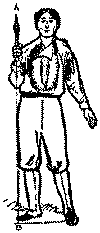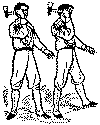By Dan Beard

Fig. 233.
Correct Position for Throw
In the good old days when our brave pioneer ancestors carried long rifles with barrels made of imported horseshoe nails, the wooden stock trimmed with brass and ornamented with eagles, 'coons, deer, and other objects cut from shells and set into the wood, they also carried tomahawks. Trusty tomahawks in the leather belt which en- circled the waist and belted in the wammus--and, like their neighbors, the redskins, many of the picturesque old fellows were expert in the use of these little camp axes as weapons of offence and defense.
Weapons of Pioneers
But the great Daniel Boone himself carried a small camp axe, almost the same as we use now (Fig. 242 shows modern camp axes with leather belt sheath), and the trees he blazed with this tomahawk to mark the boundaries of land were so well known as "Boone trees" that in after years lawsuits were decided by the identification of the blazed boundaries as the ones made by the stroke of Boone's tomahawk. This identical tomahawk of Boone's, along with one of Boone's traps, is now in the possession of a gentleman in Ohio.
When the writer was a small lad in Kentucky, it was the ambition of the boys, not to go and kill Indians, but to be able to throw a tomahawk with the skill and accuracy of our pioneer forebears, and the ability soon acquired by the boys in throwing hatchets at targets was really remarkable. They would come up to within thirty feet of an old board fence with a whoop and a yell, then "click! click! click!" would go the hatchets, each and every one sticking fast in the board, either in a true vertical or horizontal line as it pleased them. Ever since those glorious days of my boyhood in Kentucky it has seemed to me that throwing the tomahawk should be one of the regular feats at all American athletic meets.
Throwing the Tomahawk
For the benefit of the loyal scouts, I have made a series of sketches showing how to throw a hatchet, camp axe, or tomahawk, so that with a little practice the reader can astonish his friends with his skill in handling this truly American weapon. The practice is a splendid outdoor exercise, and one that trains the eyes and muscles even better than archery. Furthermore, the skill thus acquired may prove of signal service to any of the boys whose business or pleasure in after life takes them into wild and unexplored wildernesses, for a well-thrown camp axe will split the skull of as large a monster as the grizzly bear.
When the youngsters first took up the tomahawk as a plaything, of course they were very awkward in its use. There was no one to show them, and no book like this to tell them how to do anything they wanted to do, so they had to learn from experiments.
It took a long time to find out how to hold the implement as shown in Fig. 233. Each lad, without exception, began by grasping the handle of the hatchet any old way, swung it in a curve, and let it go while the blade was in a diagonal or slanting position. This would send it wobbling through the air like a boomerang, with poor results as to marksmanship, and no power to stick into the mark, for, even when the blade by chance hit the mark, it struck across the grain and the axe fell to the ground. But at last we learned to stand firmly before the mark with our feet spread apart, the weight of the body resting upon the right leg, as in Figs. 233, 234, and 235-

Figs. 234, 235.
Keep the Blade in a Vertical Line
We also learned to take aim, not by sighting along the hatchet, but by fixing our eyes on the mark, and so holding our weapon that its edge formed part of the vertical line A B, Fig. 233.
When the tomahawk is brought back from position in Fig. 233, over the shoulder as in Figs. 234 and 235, without turning the edge to one side or the other, and thrown from this position, the blade cleaves its way straight through the air, and the air itself tends to keep it true to its course.
How to Score a Hit
Take aim, as in Fig. 233, bring the tomahawk back over the shoulder, as in Figs. 234 and 235, then bring your hand quickly down, following the line A B, Fig. 233, and, swinging the body forward, let fly the tomahawk as in Fig. 236.

Fig. 236.
Note How the Hatchet
Strikes Its Edge
Between Turns Shown by Dotted Line
The weapon will turn over and over, as shown by the dotted line in the diagram. At a distance of about ten feet it will make two turns and stick (C, Fig. 236). Of course, you must learn to gauge the distance so that at the end of the last somersault the hatchet will strike the target with the cutting edge, as in Fig. 236, so that it will stick.
If the distance of the throw is to be increased, one must be sure to step back far enough to allow the hatchet to make another somersault and a rise before the cutting edge can bit. It is generally safe to count on a revolution and a half to make a hit, and one soon learns to gauge this distance, and can add or subtract a hitting distance by stepping forward or backward, as the case may be. Not only can this be done, but the novice will learn to measure a distance with his eyes, and, even at a long throw, will instinctively know whether to step forward or backward in order to make a hit, and he will also know just how his hatchet will strike the target.
Diagrams and talk can explain all this, but only practice can produce the skill and judgment which makes one so ready and rapid with the tomahawk that we call the action instinctive.
Team-Work in Tomahawking

Figs. 237, 238.
The Work of a Good
Team.
After the boys in Kentucky had acquired some skill, our greatest fault in team-work lay, not in striking out of the line, but in so delivering our tomahawks as to split the handles of those already sticking in the target.
The prettiest feature of hatchet throwing is team-work, and after you have learned to send the tomahawk whirling through the air, each one quickly following the other, so that the last one strikes the target before the first ceases to quiver, all exactly in a vertical line (Fig. 237), then it is time to attempt the more difficult feat of sinking your hatchet in the target in a horizontal line (Fig. 238); but, after this is accomplished, any sort of fancy figure that you may desire may be made on the target with the tomahawks, the simplest of which is the cross (Fig. 239).